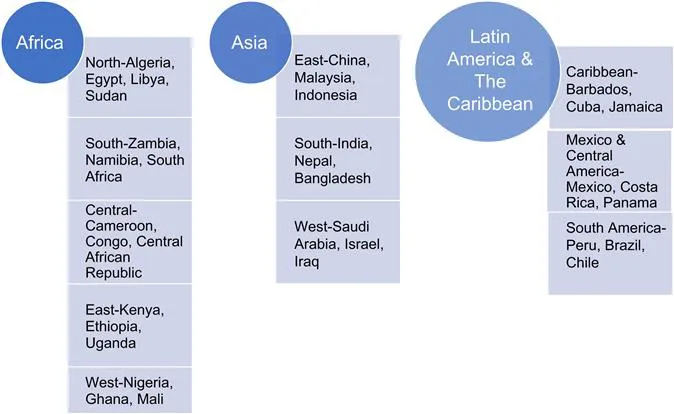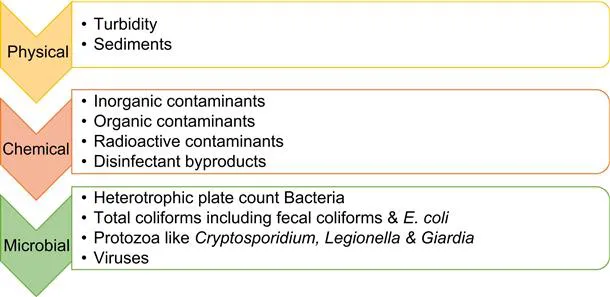![]()
Chapter 1
Introduction
1.1 Drinking Water: Availability and Need
Drinking water or potable water is water that is clean, safe and free from any physical, chemical or biological pollutants. Water is a natural resource and is available freely as almost 70% of earth’s surface is filled with water. Therefore, it can be said that drinking water availability is a human birthright. It is indeed fascinating to note that the water that we drink today has always been around in some form or another as it is recycled in the atmosphere and in our glass, which holds water. However, it must be noted that only 2.5% of the global water is freshwater and the remaining part accounts for saline water and the oceans. From this 2.5%, only about 1% is reported to be accessible while the remainder is locked in the form of glaciers and snow.
Overall, experts state that only around 0.007% of the earth’s water is available for human consumption. This amount is not sufficient to cater to the needs of the ever-increasing population on our planet. As per the statistics reported by the United Nations, the current world population is almost 7.6 billion and the birth rate is 4.3 every second. The population is expected to reach 8.6 billion by 2030, 9.8 billion in 2050 and almost 11.2 billion in the year 2100. Therefore, it can be clearly seen that the existing water resource will not be able to meet the augmenting water demands of the growing global population. It is important to note that freshwater availability is not globally well distributed due to differences in geographies, climate and environmental factors, industrialization and an upsurge in human activities.
Most of the developing countries face a major shortage of fresh water and in some instances, even if water is available, it may not be safe for human consumption and may also entail long hours of commuting to fetch it from the source. Water is very essential to sustain life and the human body is made up of 70% water. Apart from drinking, water is also needed for basic needs such as bathing, cooking and other domestic chores. According to the United Nations, the water usage rate has increased to more than twice the rate of population growth in the last century. It is very distressing to note that by the year 2025, around 1.8 billion people will be living in water scarce regions and almost two-thirds of the world’s population will be living in water strained zones mainly due to uncontrolled and extensive water usage, growth and environmental changes.
1.2 Efforts Towards Providing Clean Drinking Water
Global water regulating bodies such as the United Nations, WHO and institutions working on water quality and health such as UNICEF and many other national and local bodies have been performing a herculean task of monitoring water quality, charting guidelines and organizing programs for public awareness and safety. Over the last several decades, the world has witnessed tremendous progress in water quality management and many goals laid down by the WHO and the UN from time to time like the Millennium Development Goals (MDGs) have been successfully met.
It is very heartening to note that in the year 2015, 71% of the global population (2.6 billion) had been using a safely managed drinking water service since 1990. This implies that they used a water source that was located on the premises and that this source was freely available and free from contamination. This is indeed a huge milestone as the proportion of the global population using an improved drinking water source between 1990 and 2015 has increased from 76% to 91%. Moreover, 89% of the global population used at least a basic service, which is an improved drinking water source that is close to the premise and generally requires a round commuting trip of less than 30 mins.
Although this is a positive result, there are still many milestones to be achieved as the remaining population (663 million) still lack even a basic drinking water service and it is reported that globally at least 2 billion people use a drinking water source that may be contaminated with feces. This is very alarming since the consumption of contaminated water can result in many water borne diseases such as cholera, diarrhea, typhoid and dysentery. It is reported that each day nearly 1000 children die due to preventable water and sanitation related diarrheal diseases. Therefore, after the MDGs, the UN drafted the Sustainable Developmental Goals (SDGs) that cover a set of 17 different objectives and are mainly considered a universal call to action to end poverty, and to protect and ensure that all people enjoy peace and prosperity.
These 17 goals built on the successes of the MDGs and include new areas such as climate change, innovation, sustainable consumption etc. Interestingly, the goals are interconnected and solving one goal will often involve tackling issues related to the other. Goal 6 is ‘clean water and sanitation’ and the salient points related to clean water are that by 2030, universal and equitable access to safe and affordable drinking water should be available for all and by 2030, water quality should be improved by reducing pollution, minimizing the release of hazardous chemicals, having a proportion of untreated waste water and substantially increasing recycling and safe reuse globally. Most importantly, one of the main goals is to expand international cooperation and capacity building support to developing countries in water related activities and programmes including water harvesting, desalination, water efficiency, waste water treatment, recycling and reuse technologies.1
In this book, an attempt has been made to discuss these technologies with respect to their application in developing countries. Yet another global monitoring body is the WHO and UNICEF joint monitoring Programme for water supply, sanitation and hygiene (JMP), which has produced regular reports on the progress of the work related to goal 6, on drinking water, sanitation and hygiene, since 1990. JMP has developed a global database and was responsible for monitoring the progress of the 2015 MDG. It has now been entrusted with the responsibility of monitoring the progress of the 2030 SDG targets related to drinking water, sanitation and hygiene.
Recently, in 2017, JMP released the first update on the first global baseline estimates for the SDG targets related to drinking water. According to this update, the salient conclusion related to drinking water was that there are many people who still lack access to drinking water, especially in the rural areas. Although there are billions of people who have had access to a basic drinking water facility since 2000, these facilities do not provide safe water and the potential risk of consuming contaminated water is significant. Therefore, the risk of contracting water borne diseases is very high, especially among young children who are prone to diseases such as diarrhea, hepatitis, cholera and typhoid.
Yet another key finding in this report is that there are big gaps in services between the urban and rural areas. For instance, it is reported that two out of three people with safe managed drinking water live in urban areas and of the 161 million people who use untreated surface water (from lakes, rivers or irrigation channels), 150 million live in rural areas. This clearly points out that there is a huge requirement to improve access to safe and clean drinking water in the rural regions, which are mainly located in the developing countries across the world. Some of the developing countries are shown in Figure 1.1.
Figure 1.1 Developing Countries (Source: http://www.un.org/en/development/desa/policy/wesp/wesp_current/2014wesp_country_classification.pdf).
Thus, availability of safe and clean drinking water is the basic right of every individual and all countries globally have the responsibility to ensure that it is provided to all. This is very important in developing countries as the provision of such a basic requirement and improved services related to drinking water will ensure a bright future for the coming generation. Most importantly, enhanced water supply and better management of water resources can boost the economic growth of a country and contribute significantly to poverty reduction.2
1.3 Water Pollutants and Health Hazards
One of the most important aspects to be understood and considered in any water treatment program is the quality of the source water. It is a well-established fact that water can have a plethora of contaminants depending on the origin of water and the pollutants that find their way into water bodies from external sources. These two major contributors to the quality of water can therefore introduce a spectrum of substances that can pose a challenge in water treatment processes. For instance, variations in water compositions can be expected based on whether the raw water being treated is surface or ground water and the geographical region as well. On the other hand, due to extensive industrial and human activities over decades, waste water and sewage may find their way into water bodies thereby majorly contributing to the high level of contaminants in fresh and stored water sources.
Although describing every pollutant in detail is beyond the scope of this book, it is necessary to understand some major classes of pollutants and the health risk they cause when consumed by humans. This information is needed to comprehend the importance of water treatment, especially in the developing countries where the affected population is large in number but the economic conditions are not conducive to sophisticated treatment methods. The following sections describe the major types of pollutants, highlighting the significant ones and the diseases that can be caused in humans when water is consumed without adequate treatment.
Common water pollutants can be classified into physical, chemical and biological varieties. The major classification is given in Figure 1.2. Water usually contains physical, chemical and microbiological contaminants that pollute water and can pose serious health issues to humans. Physical pollutants include increased levels of turbidity in water, which may be due the presence of sediment or organic contaminants present in it. These factors impart an obnoxious odor and color to water thus rendering it aesthetically unacceptable by humans. These physical contaminants may have originated due to other chemical or microbiological sources that will be discussed in the following sections.
Figure 1.2 Types of Water Pollutants.
Chemical pollutants can get introduced into water from waste water and industrial effluents. These include a spectrum of inorganic contaminants such as Arsenic, lead, Mercury, Fluoride and Chromium and organic contaminants like Acrylamide, Carbon tetrachloride and vinyl chlorides and many others. Radioactive pollutants such as Uranium, and alpha and beta emitters are also reported to be found in water. For eons, chemical disinfection using chlorine, chlorine dioxide and chloramines has been used to treat water and this has been found to remain in residual amounts in treated water. Although residual disinfectants are required to prevent recontamination in water distribution systems, high levels of the same can pose a health hazard.
Disinfection byproducts (DBPs) are yet another class of important chemical contaminant that are routinely present in water if chemical disinfection is used to treat drinking water. They are generally formed due to various chemical reactions that occur between the chemical disinfectant and the organic and inorganic polluting matter found in water. Thus bromate, chlorite and trihalomethanes, which are potential carcinogens, are also deleterious compounds that fall under the class of chemical contaminants as DBPs.
Microbial pollutants form a major class of water contaminants, as they can seriously affect human health. Among the microbial contaminants, bacteria, protozoa and viruses constitute the main types that are commonly found in water. Many of these microorganisms are pathog...


